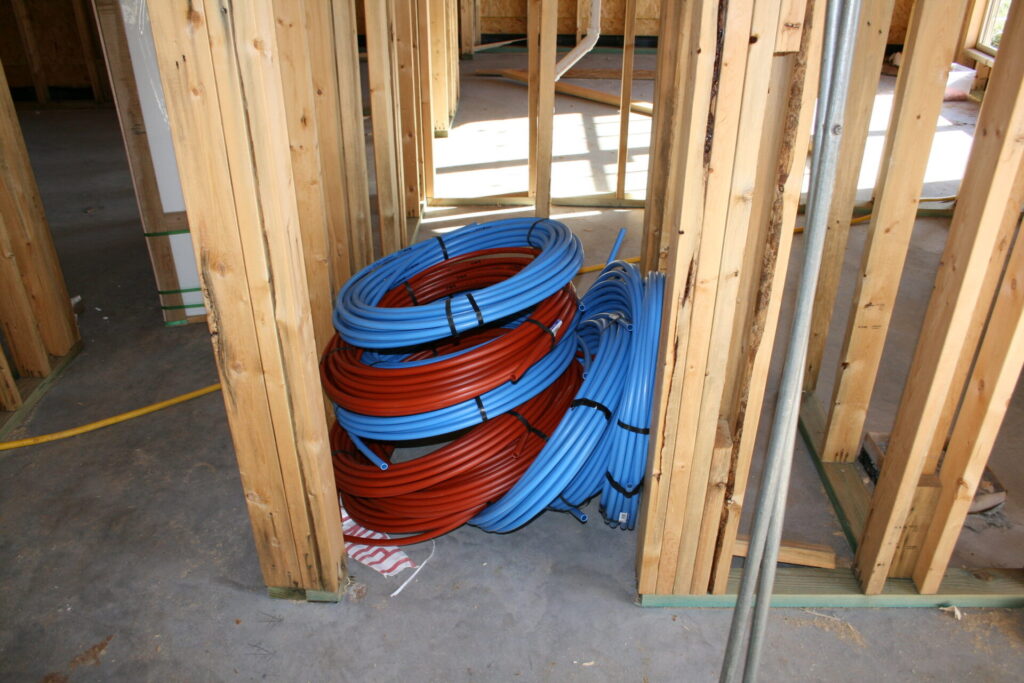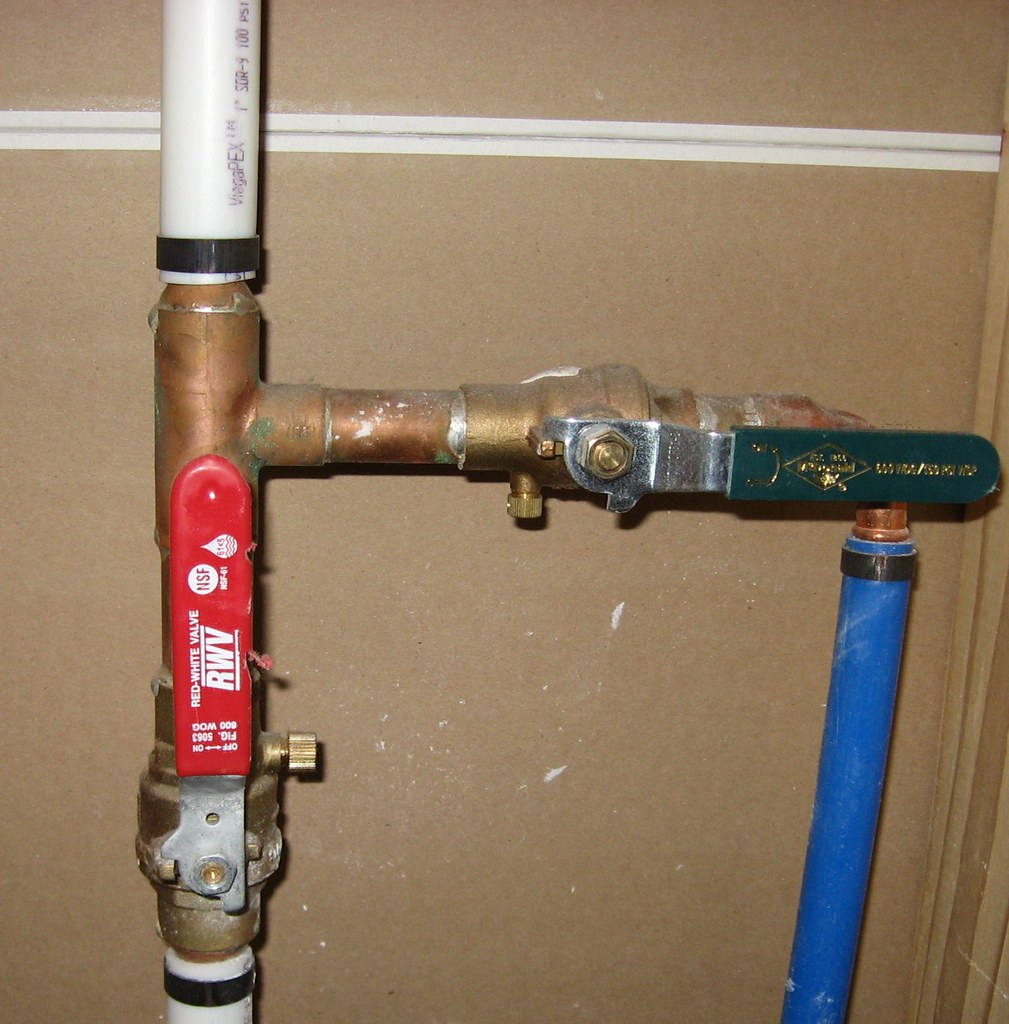
In the dynamic world of plumbing, innovations emerge that revolutionize the industry, offering both professionals and DIY enthusiasts more efficient and cost-effective solutions. One such groundbreaking innovation is PEX-B, a type of cross-linked polyethylene tubing. It’s flexible, resistant to scale and chlorine, doesn’t corrode or develop pinholes, and offers an array of benefits especially when it comes to modern shower installations and seamless connections with traditional copper systems.
But why is there a rising shift towards PEX-B in shower installations? And if you’re already accustomed to the reliability of copper, why would you want to make a transition to, or even integrate with, PEX-B? In this comprehensive guide, we’ll demystify PEX-B, delve deep into its advantages, provide step-by-step instructions for its application in shower setups, and explore the intricate world of merging PEX-B with copper piping. Whether you’re a seasoned plumber looking to stay updated or a homeowner keen on a bathroom renovation, this is your one-stop resource to mastering the art of PEX-B plumbing.
What is PEX-B and Why is it a Game-Changer?

PEX-B, which stands for cross-linked polyethylene type B, is a specific variety of PEX tubing. Through a process called “silane cross-linking,” the molecules of this plastic material bond, resulting in a flexible yet durable tube. This unique structural composition makes PEX-B one of the preferred materials in contemporary plumbing projects, especially in applications that require a blend of flexibility and strength.
Key Features and Benefits Over Traditional Piping:
- Flexibility: PEX-B tubes can navigate around obstacles, reducing the need for elbow fittings and simplifying the installation process.
- Durability: Resistant to corrosion and calcification, PEX-B ensures a longer lifespan than some traditional materials, reducing maintenance woes.
- Cost-Effective: Often more affordable than copper, PEX-B can significantly cut down on both material and labor costs.
- Compatibility: PEX-B allows for hybrid installations, integrating smoothly with existing copper pipes, thanks to various adapters and fittings.
- Eco-friendly: With its longer lifespan and fewer leak issues, PEX-B is a more sustainable choice, conserving water and reducing waste.
Freeze-Breaking Resistance and Heat Adaptability
One of the standout features of PEX-B is its resilience to temperature fluctuations. Unlike traditional materials, which can become brittle and rupture in freezing conditions, PEX-B boasts remarkable freeze-breaking resistance. This means that even when the water inside the tube freezes and expands, PEX-B can stretch to accommodate the increased volume without breaking. This feature drastically reduces the chances of burst pipes during frigid winter months.
Similarly, PEX-B is designed to withstand heat. Its adaptability to hot conditions ensures that the tubing maintains its shape, function, and integrity even when exposed to high-temperature water. This characteristic makes PEX-B an excellent choice for both cold and hot-water plumbing systems.
Shower Valve & Tub Installations with PEX

When we talk about a shower valve, we refer to the device often known as a mixing valve. This crucial component controls the flow and temperature of the water in your shower. Integrating PEX into such installations can vastly streamline the process. This is largely due to the unmatched flexibility and adaptability of PEX tubing, which contrasts sharply with more traditional, rigid pipe systems.
Similarly, in tub spout installations, the advantages of PEX are evident. The material’s flexibility allows for an easier route for water lines, simplifying the installation process and bypassing the challenges posed by rigid pipes.
One of the most celebrated benefits of PEX in shower and tub setups is the reduced installation time. Thanks to its flexibility, PEX can navigate around obstacles, which in turn minimizes the need for multiple fittings. This not only saves time but also material costs. Moreover, the ability of PEX to bend around corners means fewer joints are required. This is crucial as it decreases potential leakage points, enhancing the system’s durability.
Compatibility is another strong suit of PEX. Whether you’re dealing with a SharkBite shower valve, a Delta mixing valve, or even an existing copper system, PEX effortlessly integrates thanks to the variety of adapters available.
For those considering installing a PEX shower valve, the process begins with selecting an appropriate valve that’s compatible with PEX-B tubing. Next, accurate measurements of the required PEX tubing are taken, accounting for any turns or bends. A PEX cutter ensures a clean cut, and it’s essential to ensure the ends are devoid of any burrs. Connecting the PEX to the shower valve or to an existing copper system requires either PEX to shower valve connectors or PEX copper adapters. Once installed, it’s always wise to test the system for leaks or pressure issues before finalizing the setup.
In the context of tub spouts, precision is paramount. Correct rough-in measurements ensure the spout aligns seamlessly with your tub and wall. Securing the PEX tubing, especially near the spout, is essential to prevent any unwanted movement. If you’re also considering extending PEX to a showerhead, ensuring a tight and sealed connection is vital. Proper fittings and brackets will offer the necessary support.
Bridging the Gap: Connecting PEX-B to Copper

The reddish-brown metal has been historically revered for its non-corrosive properties, longevity, and inherent ability to resist bacterial growth, making it a plumbing staple in households and industrial setups alike.
However, the ever-evolving world of plumbing technology has introduced PEX-B as a formidable alternative, particularly due to its adaptability and cost-effectiveness. This isn’t to say that copper has been dethroned; instead, it presents a scenario where integrating PEX-B with existing copper systems can bring about the best of both worlds.
The desire to merge PEX-B and copper arises from various motivations. Foremost, integrating PEX-B with copper systems enables homeowners and plumbers to harness PEX’s flexibility and ease of installation while maintaining the strength and reliability of the existing copper lines. This integration means a smoother transition during renovation projects, allowing a seamless blend of old and new. Additionally, while copper remains a robust option, it can be pricey and labor-intensive compared to PEX-B, especially in applications requiring complex routes or numerous fittings.
For those looking to bridge the gap between these two giants of the plumbing world, the following instructions shed light on making the transition smooth:
Transitioning from Copper to PEX Without Soldering
Historically, joining two different plumbing materials would require soldering. However, soldering can be time-consuming, and it demands expertise. Thankfully, with the advent of push-fit or compression fittings like SharkBite, transitioning has become simpler. Simply cut your copper pipe cleanly, ensure there are no burrs, and push the fitting onto the copper. The PEX tubing can then be inserted into the other end of the fitting, creating a firm and reliable connection without the need for solder or flame.
Safe and Efficient Ways to Connect PEX to Copper and Vice Versa
Besides the push-fit fittings, there are other methods like using PEX copper adapters. Here, one end of the adapter is designed for a solder connection to the copper, while the other end has a PEX fitting. Once the copper end is soldered, the PEX tubing can be attached using a crimp or clamp connection. Another option is using threaded adapters, where one side connects to threaded copper fittings and the other side accommodates the PEX tubing.
Essential Fittings & Adapters for a Seamless PEX-Copper Connection
In the intricate maze of plumbing, the choice of materials—while crucial—is just the beginning. How these materials come together, form joints, and ensure leak-proof connections is where the real magic happens. This magic is conjured through the use of fittings and adapters. Ensuring you have the right ones in your toolkit is paramount to the success and longevity of your plumbing endeavors.
Venturing into the World of Fittings
Every structure, be it a skyscraper or a plumbing system, is only as strong as its weakest link. In plumbing, this ‘link’ often comes down to the fittings used. The importance of choosing the right fittings cannot be overstated. They not only ensure a secure connection but also prevent potential leakages and damages, saving both time and money in the long run.
Deciphering the Terminology
When navigating the landscape of PEX-to-copper connections, it’s essential to know the lingo. Here’s a brief breakdown:
- Adapters vs. Adaptors: While both terms are often used interchangeably, they refer to the same component—a device that allows two different plumbing systems to connect seamlessly. These can be PEX-to-copper or vice-versa.
- Connectors: This term often refers to a broader category of fittings that facilitate the joining of two pipes or tubes, irrespective of their material.
- Compression Fittings: These are unique fittings that make use of compression to form a tight seal between the tubing and the fitting. Especially useful when looking for a solder-free solution in PEX-copper transitions.
Using Fittings Like a Pro
When working with these fittings, it’s imperative to:
- Ensure that pipes and tubes are cut cleanly and free of burrs.
- Always check the compatibility of the fitting with the specific type of PEX or copper in use.
- Follow manufacturer guidelines for optimal installation, especially when using compression fittings to ensure a tight seal.
Top Recommendations
The market brims with brands offering a plethora of fittings, but some have stood the test of time and practice:
- SharkBite: Renowned for its push-to-connect fittings, SharkBite offers a hassle-free experience for those looking to connect PEX and copper without tools or solder.
- Uponor ProPEX: With a focus on expansion fittings, Uponor provides solutions that cater to those using PEX in their installations.
- Nibco: A stalwart in the plumbing industry, Nibco offers a variety of copper and PEX fittings, ensuring reliability and durability.
Understanding Copper Pipe Sizes and Their PEX Equivalents

Plumbing is an art that blends precision with functionality. At its core lies the intricate web of pipes, each with its size and purpose. The world of plumbing uses various sizing standards, with copper pipes and PEX tubing being among the most prevalent. Here, we delve into the fundamentals of pipe sizing and draw parallels between copper and its PEX equivalent.
The Nitty-Gritty of Pipe Sizing
Sizing in plumbing doesn’t merely refer to the external diameter of the pipe or tube. Instead, it often encompasses its internal diameter, wall thickness, and flow capacity. Copper, traditionally, has been sized based on its nominal or approximate inside diameter, while PEX is typically sized based on its outside diameter. This difference can lead to some confusion, especially when transitioning between the two materials.
A Comparative Gaze
Let’s decipher the sizing conundrum with a closer look at the most commonly used sizes:
- 1-inch Copper Pipe: Traditionally used for main water lines, a standard 1-inch copper pipe would have an actual outside diameter of about 1 1/8 inches. Its PEX counterpart, however, due to its outside diameter sizing, would also be labeled as 1-inch but may vary slightly based on brand and type.
- 1/2-inch Copper Pipe: Often found in domestic water lines, the 1/2-inch copper pipe has an actual outside diameter of approximately 5/8 inches. When looking for a PEX equivalent, you’d typically opt for a 1/2-inch PEX tube, though, again, there may be slight variations.
Remember, these comparisons are based on standard Type M copper pipe and might vary if you’re using a different type, such as Type L or K.
Achieving the Perfect Fit
Regardless of material, a well-fitted connection is the linchpin of a successful plumbing project. Here are some pointers to help:
- Know Your Material: PEX offers some flexibility, quite literally. It can expand and contract, making it somewhat forgiving during installations. Copper, being rigid, demands precision.
- Use the Right Tools: Especially when working with PEX, ensure you have the proper expansion or crimp tools to achieve a secure fit.
- Test Before Finalizing: Before sealing off any connections, it’s always a good idea to test the fit. Ensure there’s no undue pressure or stress at the joints, which could lead to future leaks.
Practical Tips for a Successful PEX-Copper Connection
Marrying two distinct materials like PEX and copper in a plumbing project can be like blending two different culinary worlds in a dish. It requires skill, precision, and an understanding of each ingredient. When done right, the result is harmonious and efficient. In this section, we’ll arm you with practical advice to ensure a successful connection between these two pivotal plumbing materials.
Steering Clear of Common Pitfalls
- Mismatched Sizes: One of the most common mistakes is mismatching pipe sizes. As discussed earlier, sizing varies between PEX and copper. Always double-check your sizes before making any cuts or connections.
- Improper Support: While PEX is flexible, it still needs support to prevent sagging or bending. Ensure you’re using the right supporting brackets, especially when it’s connected to the more rigid copper.
- Using the Wrong Fittings: Not every fitting or adapter that fits will work optimally. Ensure you’re using PEX-specific fittings for PEX and copper-specific ones for copper, especially when merging the two.
Your Essential Tool Kit
- PEX Expansion Tool: This tool helps expand PEX tubing to fit over fittings. It ensures a tight and secure fit once the tubing contracts.
- PEX Crimping Tool: For connections that use copper crimp rings, this tool is indispensable.
- Tubing Cutter: A clean cut ensures a better fit. Ensure you have a sharp and efficient tubing cutter for both PEX and copper.
- Deburring Tool: Especially vital for copper pipes, this tool smoothens out the cut edges to prevent leaks or tears in adjoining materials.
Quick Solutions for Common Issues
- Leaks: First, identify the source. If it’s at the connection point, ensure the fitting is secure. Sometimes, simply tightening or re-crimping can solve the problem. If the leak persists, you might need to replace the fitting or use a different size.
- Misfits: If the PEX doesn’t fit snugly over a fitting or the copper pipe seems too tight or loose, check if you’re using the correct size. It might also be worth examining if the PEX has been expanded or crimped properly.
- Water Hammering: This is when you hear a loud thud in your pipes. It can happen when water suddenly stops or changes direction. Using water hammer arrestors or adjusting water pressure can help mitigate this.
The Future of Plumbing: Beyond PEX and Copper
The world of plumbing, like many other industries, is in constant evolution. While copper has been the mainstay for years, innovations like PEX-B show how dynamic and responsive the industry has become. But as we continue to advance, what does the future hold for this essential infrastructure?
A Glimpse into Plumbing Innovations
From smart home integrations to the use of sustainable materials, the plumbing industry is on the cusp of a new era. The rise of smart water heaters and faucets that can measure water quality and usage in real-time is just the beginning. As technology becomes more entrenched in our daily lives, the plumbing systems of the future might not just transport water but also data, becoming an integral part of our smart home ecosystems.
PEX-B: A Harbinger of Change
PEX-B’s increasing popularity is more than just a passing trend—it’s indicative of a broader shift. The industry is moving towards materials that are not only efficient and reliable but also easy to install and maintain. PEX-B, with its flexibility and durability, is emblematic of these requirements. Its adaptability, from being freeze-resistant to its heat adaptability, shows how future materials will need to be resilient in the face of varying conditions.
Sustainability and the Environmental Footprint of PEX
Sustainability is no longer an added bonus but a necessity in today’s world. PEX stands out not only for its efficiency but also for its lower environmental impact. Its production requires less energy compared to metals like copper. Additionally, its longevity means reduced replacements, leading to less waste in the long run. As concerns about water scarcity and climate change intensify, the industry will likely lean more towards materials like PEX, which ensure efficient water usage and have a lower carbon footprint.
Conclusion
The dynamic world of plumbing is seeing a paradigm shift with innovations like PEX-B leading the way. As we’ve traversed the intricate interplay between traditional copper systems and the more modern PEX solutions, it’s clear that adaptability, efficiency, and sustainability are the new cornerstones of this industry. Whether you’re a professional plumber or a DIY enthusiast, staying informed about these developments is paramount. The future promises even more advancements, and by embracing the best of both PEX and copper, we are poised to meet the challenges and opportunities that lie ahead in the plumbing world.
Last Updated on August 20, 2023

Dustin Hopkins has over 12 years in the cleaning industry, working in the past for one of the top 5 cleaning companies in the US. Currently, he is the chief editor of CleaningRank.com and the proud father of a 5-year-old, Chris.
